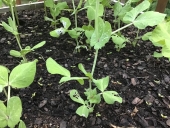
 4
4




 5
5




"Study books and observe nature; if they do not agree, throw away the books." ~ William A. Albrecht
 4
4











 4
4




 3
3




A really good treatment for powdery mildew is: 1 gal water, 1 T dish soap, 1 T baking soda.
I put it in a spray bottle to make applying it easy.
Some recipes call for adding oil. I have never found a need for the oil.
Invasive plants are Earth's way of insisting we notice her medicines. Stephen Herrod Buhner
Everyone learns what works by learning what doesn't work. Stephen Herrod Buhner
 1
1











 6
6




 2
2











 3
3





 5
5




 3
3




Joseph Lofthouse wrote:
Don't spray things on the trees that interfere with the plants protective endophytes
 5
5




This is all just my opinion based on a flawed memory

 5
5




Welcome to the serfdom.
 2
2




Phil Stevens wrote:Jon, you can use a bicarbonate antifungal on peach trees but ...







 4
4




 4
4





 3
3




 2
2








Invasive plants are Earth's way of insisting we notice her medicines. Stephen Herrod Buhner
Everyone learns what works by learning what doesn't work. Stephen Herrod Buhner

 3
3




Anne Miller wrote:Would baking soda and sour milk disrupt the cycle for trees, too?




Joseph said, "My philosophy is that the blights, diseases, and insects are doing me a favor by pointing out which plants are not able to live in the natural world as it currently exists.
Invasive plants are Earth's way of insisting we notice her medicines. Stephen Herrod Buhner
Everyone learns what works by learning what doesn't work. Stephen Herrod Buhner
 4
4




Best luck: satisfaction
Greatest curse, greed
 1
1




Invasive plants are Earth's way of insisting we notice her medicines. Stephen Herrod Buhner
Everyone learns what works by learning what doesn't work. Stephen Herrod Buhner

|
Wink, wink, nudge, nudge, say no more, it's a tiny ad:
Regionally adapted Midwest Seeds for the rest of US
http://flyoverseeds.com
|




